《化学工程与工艺专业英语》全本
化学工程与工艺专业英语(1)

化学工程与工艺专业英语1. Introduction化学工程与工艺是一门涉及化学反应、化学工艺以及工程原理的学科,它在许多工业领域中起着重要的作用。
作为一个化学工程与工艺专业的学生,具备良好的英语沟通能力对于学习和就业都具有重要意义。
本文档将介绍一些化学工程与工艺专业中常用的英语术语和短语,以帮助读者更好地理解和运用这些知识。
2. Basic Terms and Definitions在开始学习化学工程与工艺专业的英语词汇之前,我们需要了解一些基本的术语和定义。
•Chemical Engineering: 化学工程•Process: 过程•Reactor: 反应器•Mass Transfer: 质量传递•Heat Transfer: 热传递•Distillation: 蒸馏•Extraction: 提取•Polymerization: 聚合•Catalysis: 催化•Reaction Kinetics: 反应动力学•Thermodynamics: 热力学•Unit Operation: 单元操作•Unit Process: 单元工艺3. Chemical Engineering Processes化学工程与工艺专业涉及许多不同的化学过程和工艺。
下面是一些常见的过程名称和定义。
3.1 Distillation蒸馏是一种通过利用不同组分的沸点差异进行分离的过程。
在蒸馏过程中,液体混合物被加热,使其沸腾,然后通过冷凝,得到不同组分的纯液体。
蒸馏在石油化工、酒精生产和石油提炼等领域中广泛应用。
3.2 Extraction提取是一种将溶质从溶剂中分离出来的过程。
提取可以通过溶剂选择性地与溶质相互作用,使得溶质从溶剂中转移到新的相中。
提取常用于药物生产、化妆品制造等领域。
3.3 Polymerization聚合是一种将单体分子结合成长链聚合物的过程。
聚合通常需要催化剂和适当的反应条件。
聚合在塑料制造、纤维生产和涂料工业等领域中被广泛应用。
化学工程与工艺专业英语最全翻译_最全版本_大学
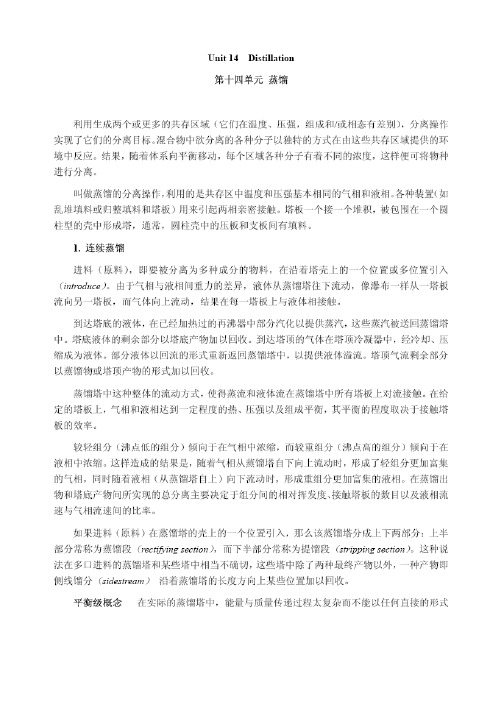
Unit 20 Material Science and Chemical Engineering材料科学和化学工程几年以前,谁会想到一架飞机可以绕地球航行而中途不需要着陆或添加燃料?而在1986年新型的飞机航海者就做到了这一点。
航海者具备长途飞行能力的秘密就在于几年前还没有出现的先进的材料。
其机身大部分是由强度大、质量轻的聚合纤维用耐久的、高强度的粘合剂组装而成的。
而发动机润滑油是合成的多组分液体,可维持很长时间连续运转的润滑性。
这些特殊材料具有科学家和工程师们为满足现代社会的需求所发明的先进技术。
如运输、通讯、电子、能量转换这些工业的未来多依赖新的、先进的材料以及生产中所需要的加工技术。
近年来,在我们了解了如何把一些特殊的具有高性能的物质融入原材料并且怎样最好地在复杂设计中使用这些材料后,这方面已有了很大的发展。
材料科学和工程的革命为化学工程师带来了机会,也带来了挑战。
化学工程师凭借他们在化学、物理和数学方面的知识基础以及他们对传输现象、动力学、反应工程和过程设计的了解,能够创造性地解决现代材料技术中的问题。
但是他们一定要摈弃掉传统职业理念中“考虑大的”这个习惯,要有效地投入现代材料科学和工程中必须要学会“从小处思考”。
在制造现代先进材料时的关键现象是发生在分子级和微观的水平。
如果化学工程师要为这些新材料设计新产品和工艺就必须了解并且学会控制这些现象。
在下面选择介绍的几种材料领域里我们将叙述这种困难的挑战。
1.聚合物现代聚合物科学的时代属于化学工程师。
这些年来,聚合物化学家创造了大量的高分子和聚合物。
然而了解这些高分子是怎样被合成并加工以最大限度地具备理论性质仍然是研究的前沿领域。
一直到最近才开发了现代仪器帮助我们了解高分子之间、高分子与固体粒子、有机和无机纤维与其它界面之间的相互作用。
化学工程师正使用这些工具探索高分子的微型动力学现象,他们利用从这些技术中获得的知识,正在处理高分子间的反应以开发先进的工艺并制造新的材料。
化学工程与工艺专业英语课文翻译
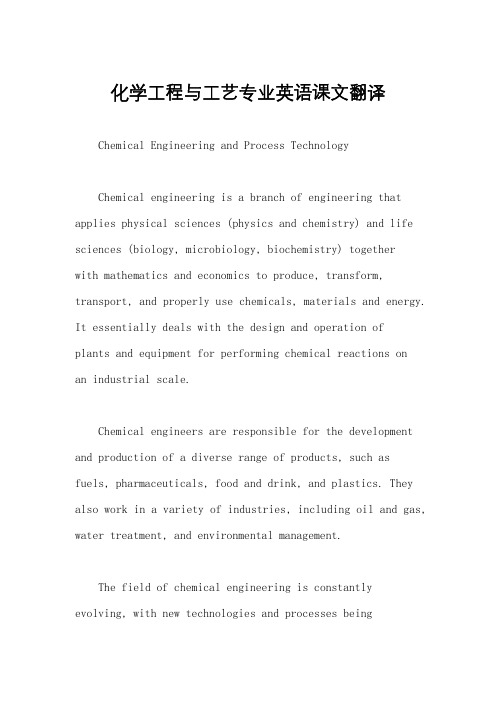
化学工程与工艺专业英语课文翻译Chemical Engineering and Process TechnologyChemical engineering is a branch of engineering that applies physical sciences (physics and chemistry) and life sciences (biology, microbiology, biochemistry) togetherwith mathematics and economics to produce, transform, transport, and properly use chemicals, materials and energy. It essentially deals with the design and operation ofplants and equipment for performing chemical reactions onan industrial scale.Chemical engineers are responsible for the development and production of a diverse range of products, such as fuels, pharmaceuticals, food and drink, and plastics. They also work in a variety of industries, including oil and gas, water treatment, and environmental management.The field of chemical engineering is constantly evolving, with new technologies and processes beingdeveloped to improve efficiency and sustainability. This requires chemical engineers to stay up-to-date with the latest developments in their field and to continually adapt their skills and knowledge.Process technology, on the other hand, focuses on the methods and techniques used to transform raw materials into useful products. This includes the design, operation, and optimization of chemical, physical, and biological processes. Process technologists work closely with chemical engineers to ensure that the processes are efficient, safe, and environmentally friendly.Some of the key areas of study within chemical engineering and process technology include thermodynamics, fluid mechanics, heat transfer, mass transfer, reaction kinetics, process control, and process design. These subjects form the foundation of the discipline and are essential for understanding and solving the complex problems that chemical engineers and process technologists face in their work.In recent years, there has been a growing emphasis on sustainability and green engineering within the field of chemical engineering and process technology. This has led to the development of new processes and technologies that minimize waste, reduce energy consumption, and limit the environmental impact of chemical production.One example of this is the use of renewable feedstocks, such as biomass, in place of traditional fossil fuels. By utilizing sustainable raw materials, chemical engineers and process technologists can help to reduce the reliance on finite resources and decrease the carbon footprint of chemical processes.Another important development in the field is the use of process intensification, which involves the integration of multiple processes into a single, more efficient system. This approach can lead to significant improvements in productivity, energy efficiency, and cost savings.As the demand for chemical products continues to grow, the role of chemical engineers and process technologists inaddressing global challenges, such as climate change and resource depletion, becomes increasingly important. By applying their knowledge and skills to develop innovative and sustainable solutions, they can help to create a more environmentally friendly and economically viable future.In conclusion, chemical engineering and process technology are dynamic and interdisciplinary fields that play a crucial role in the production of a wide range of products. With a focus on sustainability and innovation, chemical engineers and process technologists are well-positioned to address the challenges of the 21st century and contribute to the development of a more sustainable and prosperous world.。
《化学工程与工艺专业英语》中英文翻译

Unit 1 Chemical Industry化学工业1.Origins of the Chemical IndustryAlthough the use of chemicals dates back to the ancient civilizations, the evolution of what we know as the modern chemical industry started much more recently. It may be considered to have begun during the Industrial Revolution, about 1800, and developed to provide chemicals roe use by other industries. Examples are alkali for soapmaking, bleaching powder for cotton, and silica and sodium carbonate for glassmaking. It will be noted that these are all inorganic chemicals. The organic chemicals industry started in the 1860s with the exploitation of William Henry Perkin’s discovery if the first synthetic dyestuff—mauve. At the start of the twentieth century the emphasis on research on the applied aspects of chemistry in Germany had paid off handsomely, and by 1914 had resulted in the German chemical industry having 75% of the world market in chemicals. This was based on the discovery of new dyestuffs plus the development of both the contact process for sulphuric acid and the Haber process for ammonia. The later required a major technological breakthrough that of being able to carry out chemical reactions under conditions of very high pressure for the first time. The experience gained with this was to stand Germany in good stead, particularly with the rapidly increased demand for nitrogen-based compounds (ammonium salts for fertilizers and nitric acid for explosives manufacture) with the outbreak of world warⅠin 1914. This initiated profound changes which continued during the inter-war years (1918-1939).1.化学工业的起源尽管化学品的使用可以追溯到古代文明时代,我们所谓的现代化学工业的开展却是非常近代〔才开始的〕。
(最新整理)《化学工程与工艺专业英语》课文翻译

(完整)《化学工程与工艺专业英语》课文翻译编辑整理:尊敬的读者朋友们:这里是精品文档编辑中心,本文档内容是由我和我的同事精心编辑整理后发布的,发布之前我们对文中内容进行仔细校对,但是难免会有疏漏的地方,但是任然希望((完整)《化学工程与工艺专业英语》课文翻译)的内容能够给您的工作和学习带来便利。
同时也真诚的希望收到您的建议和反馈,这将是我们进步的源泉,前进的动力。
本文可编辑可修改,如果觉得对您有帮助请收藏以便随时查阅,最后祝您生活愉快业绩进步,以下为(完整)《化学工程与工艺专业英语》课文翻译的全部内容。
Unit 1 Chemical Industry化学工业1.Origins of the Chemical IndustryAlthough the use of chemicals dates back to the ancient civilizations, the evolution of what we know as the modern chemical industry started much more recently. It may be considered to have begun during the Industrial Revolution, about 1800, and developed to provide chemicals roe use by other industries. Examples are alkali for soapmaking,bleaching powder for cotton, and silica and sodium carbonate for glassmaking。
It will be noted that these are all inorganic chemicals. The organic chemicals industry started in the 1860s with the exploitation of William Henry Perkin’s discovery if the first synthetic dyestuff—mauve. At the start of the twentieth century the emphasis on research on the applied aspects of chemistry in Germany had paid off handsomely, and by 1914 had resulted in the German chemical industry having 75% of the world market in chemicals. This was based on the discovery of new dyestuffs plus the development of both the contact process for sulphuric acid and the Haber process for ammonia. The later required a major technological breakthrough that of being able to carry out chemical reactions under conditions of very high pressure for the first time. The experience gained with this was to stand Germany in good stead, particularly with the rapidly increased demand for nitrogen—based compounds (ammonium salts for fertilizersand nitric acid for explosives manufacture) with the outbreak of world warⅠin 1914. This initiated profound changes which continued during the inter—war years (1918—1939)。
《化学工程与工艺专业英语》课文翻译

Unit 1 Chemical Industry化学工业organic chemicals industry started in the 1860s with the exploitation of William Henry Perkin’s discovery if the first synthetic dyestuff—mauve. At the start of the twentieth century the emphasis on research on the applied aspects of chemistry in Germany had paid off handsomely, and by 1914 had resulted in the German chemical industry having 75% of the world market in chemicals. This was based on the discovery of new dyestuffs plus the development of both the contact process for sulphuric acid and the Haber process for ammonia. The later required a major technological breakthrough that of being able to carry out chemical reactions under conditions of very high pressure for the first time. The experience gained with this was to stand Germany in good stead, particularly with the rapidly increased demand for nitrogen-based compounds (ammonium salts for fertilizers and nitric acid for explosives manufacture) with the outbreak of world warⅠin 1914. This initiated profound changes which continued during the inter-war years (1918-1939).1.化学工业的起源尽管化学品的使用可以追溯到古代文明时代,我们所谓的现代化学工业的发展却是非常近代(才开始的)。
化学工程与工艺专业英语unit1精品文档

into them. The difficultly comes in deciding at which point in this sequence the particular operation ceases to be part of the chemical industry’s sphere of activities, To consider a specific example to illustrate this dilemma, emulsion paints may contain poly (vinyl chloride)/poly (vinyl acetate). Clearly, synthesis of vinyl chloride (or acetate) and its polymerization are chemical activities. However, if formulation and mixing of the paint, including the polymer,
has made to meet and satisfy our needs? 4 . Is the chemical industry capital-or labor-intensive? Why?
1. Origins of the Chemical Industry
Although the use of chemicals dates back to the ancient civilizations, the evolution of what we know as the modern chemical industry started much more recently. It may be considered to have begun during the Industrial Revolution, about 1800,and developed to provide chemicals for use by other industries. Examples are alkali for soapmaking, bleaching powder for cotton, and silica and sodium carbonate for glassmaking.
化学工程与工艺专业英语
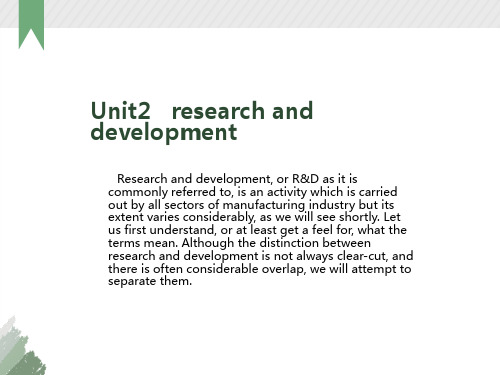
the development. 2. Types of Industrial Research and Development The applied or more targeted type of research and
development commonly carried out in industry can be of several type and we will briefly consider each. They are: (i) product development, (ii) process development, (iii) process improvement and (iv) applications development. Even under these headings there are a multitude of aspect so only a typical example can be quoted in each case. The emphasis on each of these will vary considerably within the different sectors of the chemical industry. Product development. Product development
化学工程与工艺专业英语
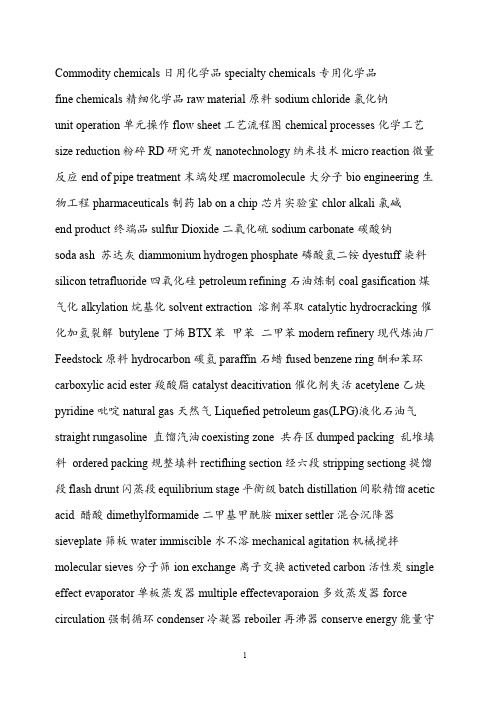
Commodity chemicals日用化学品specialty chemicals专用化学品fine chemicals精细化学品raw material原料sodium chloride氯化钠unit operation单元操作flow sheet工艺流程图chemical processes化学工艺size reduction粉碎RD研究开发nanotechnology纳米技术micro reaction微量反应end of pipe treatment末端处理macromolecule大分子bio engineering生物工程pharmaceuticals制药lab on a chip芯片实验室chlor alkali氯碱end product终端品sulfur Dioxide二氧化硫sodium carbonate碳酸钠soda ash 苏达灰diammonium hydrogen phosphate磷酸氢二铵dyestuff染料silicon tetrafluoride四氧化硅petroleum refining石油炼制coal gasification煤气化alkylation烷基化solvent extraction 溶剂萃取catalytic hydrocracking催化加氢裂解butylene丁烯BTX苯甲苯二甲苯modern refinery现代炼油厂Feedstock原料hydrocarbon碳氢paraffin石蜡fused benzene ring酬和苯环carboxylic acid ester羧酸脂catalyst deacitivation催化剂失活acetylene乙炔pyridine吡啶natural gas天然气Liquefied petroleum gas(LPG)液化石油气straight rungasoline 直馏汽油coexisting zone 共存区dumped packing 乱堆填料ordered packing规整填料rectifhing section经六段stripping sectiong提馏段flash drunt闪蒸段equilibrium stage平衡级batch distillation间歇精馏acetic acid 醋酸dimethylformamide二甲基甲酰胺mixer settler混合沉降器sieveplate筛板water immiscible水不溶mechanical agitation机械搅拌molecular sieves分子筛ion exchange离子交换activeted carbon活性炭single effect evaporator单板蒸发器multiple effectevaporaion多效蒸发器force circulation强制循环condenser冷凝器reboiler再沸器conserve energy能量守恒Reflux pump回流泵reversible process可逆过程dynamic equilibrium 动力学平衡entropy熵In bulk 大剂量汉翻英氢氧化钠Sodium hydroxide 硫酸Sulfuric acid 有机合成Organic synthesis 表面活性剂surfactant离子交换Ion exchange热传递Heat transfer工艺流程图Process flow diagram副产物by-products盐酸Hydrochloric acid无机化学品Inorganic chemicals硝酸Nitric acid氢氧化钙Calcium hydroxide磷酸phosphate 硅胶Silica gel煤气厂gasworks水处理Water treatment石油化学品Petroleum chemical原油Crude oil精馏distillation沸点Boiling point催化重整Catalytic reforming异构化isomerization生物柴油biodiesel 燃油fuel环烷烃cycloparaffin 甲烷methane丙烷propane 乙烯ethylene树脂Resin五元环Five member ring苯benzene杂原子化合物Heteroatom compound相态Phase state气相gas phase液相liquid phase相对挥发度Relative volatility流速flow rate冷凝器condenser多组分混合物Multicomponent mixture回流比reflux ratio萃取器extractor结晶crystallization吸收absorption吸附adsorption解吸desorption溶质solute溶解性solubility沉淀precipitation1.We define industrial chemistry as the branch of chemistry which applies physical chemical procedures towards the transformation of natural raw materials and their derivatives to products that are of benefit to humanity. 我们定义的工业化学是化学的一个分支,应用物理化学程序对改造天然原材料及其衍生物产品,造福人类。
《化学工程与工艺专业英语》课文翻译

Unit 1 Chemical Industry化学工业the emphasis on research on the applied aspects of chemistry in Germany had paid off handsomely, and by 1914 had resulted in the German chemical industry having 75% of the world market in chemicals. This was based on the discovery of new dyestuffs plus the development of both the contact process for sulphuric acid and the Haber process for ammonia. The later required a major technological breakthrough that of being able to carry out chemical reactions under conditions of very high pressure for the first time. The experience gained with this was to stand Germany in good stead, particularly with the rapidly increased demand for nitrogen-based compounds (ammonium salts for fertilizers and nitric acid for explosives manufacture) with the outbreak of world warⅠin 1914. This initiated profound changes which continued during the inter-war years (1918-1939).1.化学工业的起源尽管化学品的使用可以追溯到古代文明时代,我们所谓的现代化学工业的发展却是非常近代(才开始的)。
化学工程与工艺专业英语最全版

1.The explosives growth in petrochemicals in the 1960s and 1970s was largely due to the enormous increase in demand for synthet ic polymers such as polyethylene, polypropylene, nylon, polyesters and epoxy resins.石油化工在60年代和70年代的迅猛发展主要是由于人们对于合成高聚物如聚乙烯、聚丙烯、尼龙、聚脂和环氧树脂的需求巨大增加。
2.The difficulty cones in deciding at which point in this sequence the particular operation ceases to be part of the chemical industry’s sphere of activities. 困难在于如何决定在一些特殊的生产过程中哪一个环节不再属于化学工业的活动范畴。
举一个特殊的例子来描述一下这种困境。
3.The chemical engineer must also work closely with mechanical, electrical, civil, and metallurgical engineers in order to design and operate the physical equipment in a plant--the reactors, tanks, distillation columns, heat exchangers, pumps, compressors, Control and instrumentation devices, and so on. 化学工程师还必须与机械、电子、土木建筑和冶金工程师密切协作以设计和操作工厂的机械设备—反应器、槽、蒸馏塔、热交换器、泵、压缩机、控制器和仪器设备等等。
《化学工程与工艺专业英语》中英文翻译

Unit 1 Chemical Industry化学工业1.Origins of the Chemical IndustryAlthough the use of chemicals dates back to the ancient civilizations, the evolution of what we know as the modern chemical industry started much more recently. It may be considered to have begun during the Industrial Revolution, about 1800, and developed to provide chemicals roe use by other industries. Examples are alkali for soapmaking, bleaching powder for cotton, and silica and sodium carbonate for glassmaking. It will be noted that these are all inorganic chemicals. The organic chemicals industry started in the 1860s with the exploitation of William Henry Perkin’s discovery if the first synthetic dyestuff—mauve. At the start of the twentieth century the emphasis on research on the applied aspects of chemistry in Germany had paid off handsomely, and by 1914 had resulted in the German chemical industry having 75% of the world market in chemicals. This was based on the discovery of new dyestuffs plus the development of both the contact process for sulphuric acid and the Haber process for ammonia. The later required a major technological breakthrough that of being able to carry out chemical reactions under conditions of very high pressure for the first time. The experience gained with this was to stand Germany in good stead, particularly with the rapidly increased demand for nitrogen-based compounds (ammonium salts for fertilizers and nitric acid for explosives manufacture) with the outbreak of world warⅠin 1914. This initiated profound changes which continued during the inter-war years (1918-1939).1.化学工业的起源尽管化学品的使用可以追溯到古代文明时代,我们所谓的现代化学工业的发展却是非常近代(才开始的)。
《化学工程与工艺专业英语》课文翻译-完整版
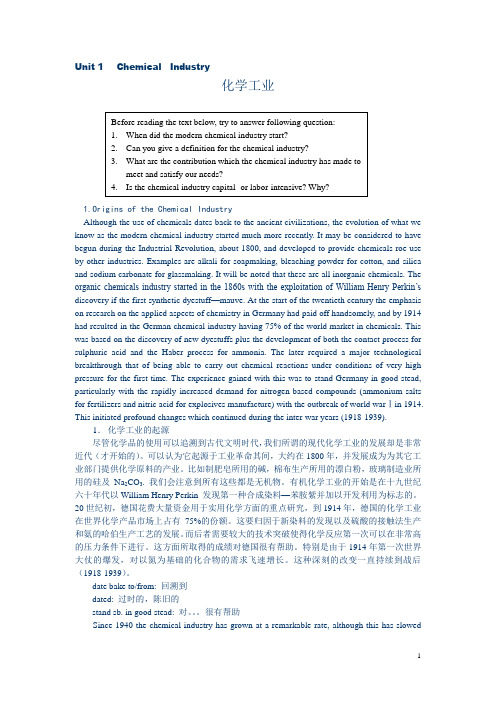
Unit 1 Chemical Industry化学工业1.Origins of the Chemical IndustryAlthough the use of chemicals dates back to the ancient civilizations, the evolution of what we know as the modern chemical industry started much more recently. It may be considered to have begun during the Industrial Revolution, about 1800, and developed to provide chemicals roe use by other industries. Examples are alkali for soapmaking, bleaching powder for cotton, and silica and sodium carbonate for glassmaking. It will be noted that these are all inorganic chemicals. The organic chemicals industry started in the 1860s with the exploitation of William Henry Perkin’s discovery if the first synthetic dyestuff—mauve. At the start of the twentieth century the emphasis on research on the applied aspects of chemistry in Germany had paid off handsomely, and by 1914 had resulted in the German chemical industry having 75% of the world market in chemicals. This was based on the discovery of new dyestuffs plus the development of both the contact process for sulphuric acid and the Haber process for ammonia. The later required a major technological breakthrough that of being able to carry out chemical reactions under conditions of very high pressure for the first time. The experience gained with this was to stand Germany in good stead, particularly with the rapidly increased demand for nitrogen-based compounds (ammonium salts for fertilizers and nitric acid for explosives manufacture) with the outbreak of world warⅠin 1914. This initiated profound changes which continued during the inter-war years (1918-1939).1.化学工业的起源尽管化学品的使用可以追溯到古代文明时代,我们所谓的现代化学工业的发展却是非常近代(才开始的)。
《化学工程与工艺专业英语》翻译资料电子版
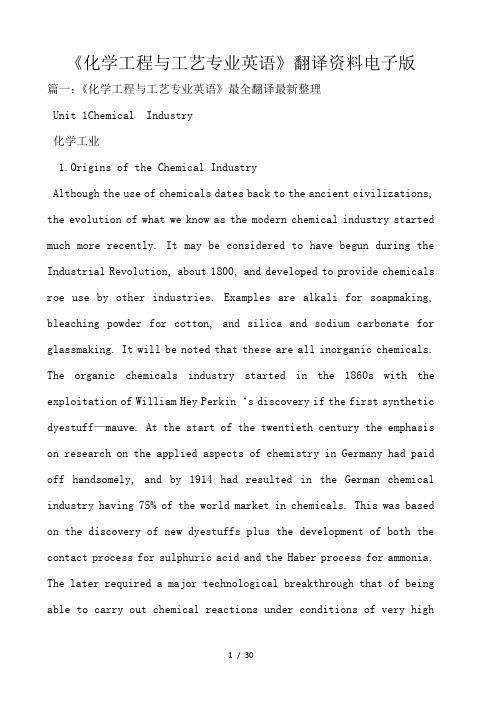
《化学工程与工艺专业英语》翻译资料电子版篇一:《化学工程与工艺专业英语》最全翻译最新整理Unit 1Chemical Industry化学工业1.Origins of the Chemical IndustryAlthough the use of chemicals dates back to the ancient civilizations, the evolution of what we know as the modern chemical industry started much more recently. It may be considered to have begun during the Industrial Revolution, about 1800, and developed to provide chemicals roe use by other industries. Examples are alkali for soapmaking, bleaching powder for cotton, and silica and sodium carbonate for glassmaking. It will be noted that these are all inorganic chemicals. The organic chemicals industry started in the 1860s with the exploitation of William Hey Perkin‘s discovery if the first synthetic dyestuff—mauve. At the start of the twentieth century the emphasis on research on the applied aspects of chemistry in Germany had paid off handsomely, and by 1914 had resulted in the German chemical industry having 75% of the world market in chemicals. This was based on the discovery of new dyestuffs plus the development of both the contact process for sulphuric acid and the Haber process for ammonia. The later required a major technological breakthrough that of being able to carry out chemical reactions under conditions of very highpressure for the first time. The experience gained with this was to stand Germany in good stead, particularly with the rapidly increased demand for nitrogen-based compounds (ammonium salts for fertilizers and nitric acid for explosives manufacture) with the outbreak of world warⅠin 1914. This initiated profound changes which continued during the inter-war years (1918-1939).1.化学工业的起源尽管化学品的使用可以追溯到古代文明时代,我们所谓的现代化学工业的发展却是非常近代(才开始的)。
化学工程与工艺专业英语全本

Unit 1 Chemical Industry化学工业Although the use of chemicals dates back to the ancient civilizations, the evolution of what we know as the modern chemical industry started much more recently. It may be considered to have begun during the Industrial Revolution, about 1800, and developed to provide chemicals roe use by other industries. Examples are alkali for soapmaking, bleaching powder for cotton, and silica and sodium carbonate for glassmaking. It will be noted that these are all inorganic chemicals. The organic chemicals industry started in the 1860s with the exploitation of William Henry Perkin’s discovery if the first synthetic dyestuff—mauve. At the start of the twentieth century the emphasis on research on the applied aspects of chemistry in Germany had paid off handsomely, and by 1914 had resulted in the German chemical industry having 75% of the world market in chemicals. This was based on the discovery of new dyestuffs plus the development of both the contact process for sulphuric acid and the Haber process for ammonia. The later required a major technological breakthrough that of being able to carry out chemical reactions under conditions of very high pressure for the first time. The experience gained with this was to stand Germany in good stead, particularly with the rapidly increased demand for nitrogen-based compounds (ammonium salts for fertilizers and nitric acid for explosives manufacture) with the outbreak of world warⅠin 1914. This initiated profound changes which continued during the inter-war years (1918-1939).1.化学工业的起源尽管化学品的使用可以追溯到古代文明时代,我们所谓的现代化学工业的发展却是非常近代(才开始的)。
《化学工程与工艺专业英语》全本

Unit 1 Chemical Industry化学工业Although the use of chemicals dates back to the ancient civilizations, the evolution of what we know as the modern chemical industry started much more recently. It may be considered to have begun during the Industrial Revolution, about 1800, and developed to provide chemicals roe use by other industries. Examples are alkali for soapmaking, bleaching powder for cotton, and silica and sodium carbonate for glassmaking. It will be noted that these are all inorganic chemicals. The organic chemicals industry started in the 1860s with the exploitation of William Henry Perkin’s discovery if the first synthetic dyestuff—mauve. At the start of the twentieth century the emphasis on research on the applied aspects of chemistry in Germany had paid off handsomely, and by 1914 had resulted in the German chemical industry having 75% of the world market in chemicals. This was based on the discovery of new dyestuffs plus the development of both the contact process for sulphuric acid and the Haber process for ammonia. The later required a major technological breakthrough that of being able to carry out chemical reactions under conditions of very high pressure for the first time. The experience gained with this was to stand Germany in good stead, particularly with the rapidly increased demand for nitrogen-based compounds (ammonium salts for fertilizers and nitric acid for explosives manufacture) with the outbreak of world warⅠin 1914. This initiated profound changes which continued during the inter-war years (1918-1939).1.化学工业的起源尽管化学品的使用可以追溯到古代文明时代,我们所谓的现代化学工业的发展却是非常近代(才开始的)。
化学工程与工艺专业英语原文what do we mean by transport phenomena
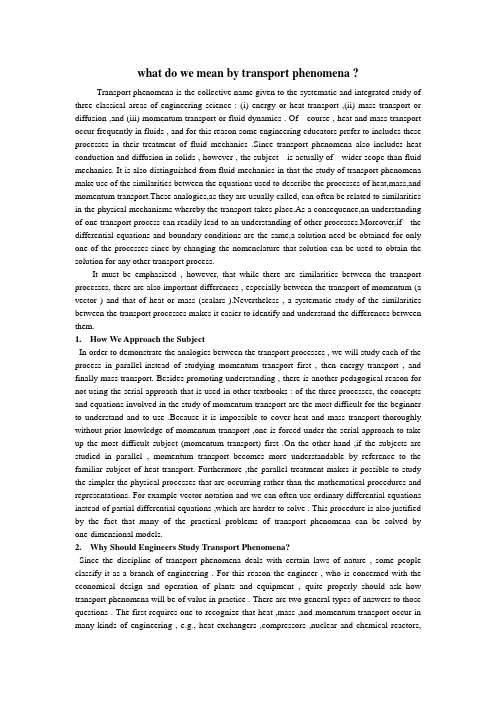
what do we mean by transport phenomena ?Transport phenomena is the collective name given to the systematic and integrated study of three classical areas of engineering science : (i) energy or heat transport ,(ii) mass transport or diffusion ,and (iii) momentum transport or fluid dynamics . Of course , heat and mass transport occur frequently in fluids , and for this reason some engineering educators prefer to includes these processes in their treatment of fluid mechanics .Since transport phenomena also includes heat conduction and diffusion in solids , however , the subject is actually of wider scope than fluid mechanics. It is also distinguished from fluid mechanics in that the study of transport phenomena make use of the similarities between the equations used to describe the processes of heat,mass,and momentum transport.These analogies,as they are usually called, can often be related to similarities in the physical mechanisms whereby the transport takes place.As a consequence,an understanding of one transport process can readily lead to an understanding of other processes.Moreover,if the differential equations and boundary conditions are the same,a solution need be obtained for only one of the processes since by changing the nomenclature that solution can be used to obtain the solution for any other transport process.It must be emphasized , however, that while there are similarities between the transport processes, there are also important differences , especially between the transport of momentum (a vector ) and that of heat or mass (scalars ).Nevertheless , a systematic study of the similar ities between the transport processes makes it easier to identify and understand the differences between them.1.How We Approach the SubjectIn order to demonstrate the analogies between the transport processes , we will study each of the process in parallel-instead of studying momentum transport first , then energy transport , and finally mass transport. Besides promoting understanding , there is another pedagogical reason for not using the serial approach that is used in other textbooks : of the three processes, the concepts and equations involved in the study of momentum transport are the most difficult for the beginner to understand and to use .Because it is impossible to cover heat and mass transport thoroughly without prior knowledge of momentum transport ,one is forced under the serial approach to take up the most difficult subject (momentum transport) first .On the other hand ,if the subjects are studied in parallel , momentum transport becomes more understandable by reference to the familiar subject of heat transport. Furthermore ,the parallel treatment makes it possible to study the simpler the physical processes that are occurring rather than the mathematical procedures and representations. For example vector notation and we can often use ordinary differential equations instead of partial differential equations ,which are harder to solve . This procedure is also justified by the fact that many of the practical problems of transport phenomena can be solved by one-dimensional models.2.Why Should Engineers Study T ransport Phenomena?Since the discipline of transport phenomena deals with certain laws of nature , some people classify it as a branch of engineering . For this reason the engineer , who is concerned with the economical design and operation of plants and equipment , quite properly should ask how transport phenomena will be of value in practice . There are two general types of answers to those questions . The first requires one to recognize that heat ,mass ,and momentum transport occur in many kinds of engineering , e.g., heat exchangers ,compressors ,nuclear and chemical reactors,humidifiers, air coolers ,driers , fractionaters , and absorbers. These transport processes are also involved in the human body as well as in the complex processes whereby pollutants react and diffuse in the atmosphere.It is important that engineers have an understanding of the physical laws governing these transport processes if they are to understand what is taking place in engineering equipment and to make wise decisions with regard to its economical operation .The second answer is that engineers need to be able to use their understanding of natural laws to design process equipment in which these processes are occurring . To do so they must be able to predict rates of heat ,mass , or momentum transport .For example, consider a simple heat exchanger , i.e., a pipe used to heat a fluid by maintaining its wall at a higher temperature than that of the fluid flowing through it .The rate at which heat passes from the wall of the pipe to the fluid depends upon a parameter , etc.Traditionally heat-transfer coefficients are obtained after expensive and time-consuming laboratory or pilot-plant measurements and are correlated through the use of dimensionless empirical equations. Empirical equations are equations that fit the data over a certain range; they are not based upon theory and cannot be used accurately outside the range for which the data have heen taken .The less expensive and usually more reliable approach used in transport phenomena is to predict the heat-transfer coefficient from equations based on the laws of nature . The predicted result would be obtained by a research engineer by solving some equations (often on a computer ). A design engineer would then use the equation for the heat-transfer coefficient obtained by the research engineer .Keep in mind that the job of designing the heat exchanger would be essentially the same no matter how the heat-transfer coefficients were originally obtained. For this reason ,some courses in transport phenomena emphasize only the determination of the heat-transfer coefficient and leave the actual design procedure to a course in unit oper ations .It is of cource a “practical “ matter to be able to obtain the parameters , i.e., the heat-transfer coefficients that are used in design , and for that reason a transport phenomena course can be considered an engineering course as well as one in science .In fact , there are some cases in which the design engineer might use the methods and equations of transport phenomena directly in the design of equipment .An example would be a tubular reactor ,which might be illustrated as a pipe ,e.g., the heat exchanger described earlier, with a homogeneous chemical reaction occurring in the fluid within .The fluid enters with a certain concentration of reactant and leaves the tube with a decreased concentration of reactant and an increased concentration of product .If the reaction is exothermic , the reactor wall will usually be maintained at a low temperature in order to remove the heat generated by the chemical reaction . Therefore the temperature will decrease with radial position , i.e.,with the distance from the centerline of the pipe . Then , since the reaction rate increases with temperature , it will be higher at the center ,where the temperature is high , than at the wall , where the temperature is low . Accordingly ,the products of the reaction will tend to accumulate at the centerline while the reactants accumulate near the wall of the reactor . Hence , concentration as well as temperature will vary both with radial position and with length .To design the reactor we would need to know ,at any given length , the mean concentration of product . Since this mean concentration is obtained from the point values averaged over the cross section , we actually need to obtain the concentration at every point in the reactor , i.e., at every radial position and at every length . But to calculate the concentration at every point weneed to know the reaction rate at every point , and to calculate the rate at every point we need to know both the temperature and the concentration at every point ! Furthermore, to calculate the temperature we also need to know the rate and the velocity of the fluid at every point . We will not go into the equations involved ,but obviously we have a complicated set of partial differential equations that must be solved by sophisticated procedures, usually on a computer. It should be apparent that we could not handle such a problem by the empirical design procedures used in unit operations courses for a heat exchanger . Instead the theory and mathematical procedures of transport phenomena are essential ,unless one wishes to go go the expense and take the time to build pilot plants of increasing size and measure the conersion in each . Even then the final scale-up is precarious and uncertain.Of course ,not all problems today can be solved by the methods of transport phenomena. However, with the development of the computer ,more and more problems are being solved by these methods .If engineering students are to have an education that is not become obsolete , they must be prepared, through an understanding of the methods of transport phenomena , to make use of the computations that will be made in the future .Because of its great potential as well as its current usefulness , a course in transport phenomena may ultimately prove to be the most prac tical and useful course on a student’s undergraduate career.。
《化学工程与工艺专业英语》课文翻译

《化学工程与工艺专业英语》课文翻译.txt 生活是一张千疮百孔的网,它把所有激情的水都漏光了。
寂寞就是你说话时没人在听,有人在听时你却没话说了!本文由hufei0419贡献doc文档可能在WAP端浏览体验不佳。
建议您优先选择TXT,或下载源文件到本机查看。
Unit 1Chemical Industry 化学工业1.化学工业的起源尽管化学品的使用可以追溯到古代文明时代,我们所谓的现代化学工业的发展却是非常近代(才开始的)。
可以认为它起源于工业革命其间,大约在 1800 年,并发展成为为其它工业部门提供化学原料的产业。
比如制肥皂所用的碱,棉布生产所用的漂白粉,玻璃制造业所用的硅及 Na2CO3. 我们会注意到所有这些都是无机物。
有机化学工业的开始是在十九世纪六十年代以 William Henry Perkin 发现第一种合成染料—苯胺紫并加以开发利用为标志的。
20 世纪初,德国花费大量资金用于实用化学方面的重点研究,到 1914 年,德国的化学工业在世界化学产品市场上占有 75%的份额。
这要归因于新染料的发现以及硫酸的接触法生产和氨的哈伯生产工艺的发展。
而后者需要较大的技术突破使得化学反应第一次可以在非常高的压力条件下进行。
这方面所取得的成绩对德国很有帮助。
特别是由于 1914 年第一次世界大仗的爆发,对以氮为基础的化合物的需求飞速增长。
这种深刻的改变一直持续到战后(1918-1939)。
date bake to/from: 回溯到 dated: 过时的,陈旧的 stand sb. in good stead: 对。
很有帮助。
11940 年以来,化学工业一直以引人注目的速度飞速发展。
尽管这种发展的速度近年来已大大减慢。
化学工业的发展由于 1950 年以来石油化学领域的研究和开发大部分在有机化学方面取得。
石油化工在 60 年代和 70 年代的迅猛发展主要是由于人们对于合成高聚物如聚乙烯、聚丙烯、尼龙、聚脂和环氧树脂的需求巨大增加。
- 1、下载文档前请自行甄别文档内容的完整性,平台不提供额外的编辑、内容补充、找答案等附加服务。
- 2、"仅部分预览"的文档,不可在线预览部分如存在完整性等问题,可反馈申请退款(可完整预览的文档不适用该条件!)。
- 3、如文档侵犯您的权益,请联系客服反馈,我们会尽快为您处理(人工客服工作时间:9:00-18:30)。
Unit 1 Chemical Industry化学工业Although the use of chemicals dates back to the ancient civilizations, the evolution of what we know as the modern chemical industry started much more recently. It may be considered to have begun during the Industrial Revolution, about 1800, and developed to provide chemicals roe use by other industries. Examples are alkali for soapmaking, bleaching powder for cotton, and silica and sodium carbonate for glassmaking. It will be noted that these are all inorganic chemicals. The organic chemicals industry started in the 1860s with the exploitation of William Henry Perkin’s discovery if the first synthetic dyestuff—mauve. At the start of the twentieth century the emphasis on research on the applied aspects of chemistry in Germany had paid off handsomely, and by 1914 had resulted in the German chemical industry having 75% of the world market in chemicals. This was based on the discovery of new dyestuffs plus the development of both the contact process for sulphuric acid and the Haber process for ammonia. The later required a major technological breakthrough that of being able to carry out chemical reactions under conditions of very high pressure for the first time. The experience gained with this was to stand Germany in good stead, particularly with the rapidly increased demand for nitrogen-based compounds (ammonium salts for fertilizers and nitric acid for explosives manufacture) with the outbreak of world warⅠin 1914. This initiated profound changes which continued during the inter-war years (1918-1939).1.化学工业的起源尽管化学品的使用可以追溯到古代文明时代,我们所谓的现代化学工业的发展却是非常近代(才开始的)。
可以认为它起源于工业革命其间,大约在1800年,并发展成为为其它工业部门提供化学原料的产业。
比如制肥皂所用的碱,棉布生产所用的漂白粉,玻璃制造业所用的硅及Na2CO3. 我们会注意到所有这些都是无机物。
有机化学工业的开始是在十九世纪六十年代以William Henry Perkin 发现第一种合成染料—苯胺紫并加以开发利用为标志的。
20世纪初,德国花费大量资金用于实用化学方面的重点研究,到1914年,德国的化学工业在世界化学产品市场上占有75%的份额。
这要归因于新染料的发现以及硫酸的接触法生产和氨的哈伯生产工艺的发展。
而后者需要较大的技术突破使得化学反应第一次可以在非常高的压力条件下进行。
这方面所取得的成绩对德国很有帮助。
特别是由于1914年第一次世界大仗的爆发,对以氮为基础的化合物的需求飞速增长。
这种深刻的改变一直持续到战后(1918-1939)。
date bake to/from: 回溯到dated: 过时的,陈旧的stand sb. in good stead: 对。
很有帮助Since 1940 the chemical industry has grown at a remarkable rate, although this has slowed significantly in recent years. The lion’s share of this growth has been in the organic chemicals sector due to the development and growth of the petrochemicals area since 1950s. The explosives growth in petrochemicals in the 1960s and 1970s was largely due to the enormous increase in demand for synthetic polymers such as polyethylene, polypropylene, nylon, polyesters and epoxy resins.1940年以来,化学工业一直以引人注目的速度飞速发展。
尽管这种发展的速度近年来已大大减慢。
化学工业的发展由于1950年以来石油化学领域的研究和开发大部分在有机化学方面取得。
石油化工在60年代和70年代的迅猛发展主要是由于人们对于合成高聚物如聚乙烯、聚丙烯、尼龙、聚脂和环氧树脂的需求巨大增加。
The chemical industry today is a very diverse sector of manufacturing industry, within which it plays a central role. It makes thousands of different chemicals which the general public only usually encounter as end or consumer products. These products are purchased because they have the required properties which make them suitable for some particular application, e.g. a non-stick coating品,而人们通常只接触到终端产品或消费品。
这些产品被购买是因为他们具有某些性质适合(人们)的一些特别的用途,例如,用于盆的不粘涂层或一种杀虫剂。
这些化学产品归根到底是由于它们能产生的作用而被购买的。
2. Definition of the Chemical IndustryAt the turn of the century there would have been little difficulty in defining what constituted the chemical industry since only a very limited range of products was manufactured and these were clearly chemicals, e.g., alkali, sulphuric acid. At present, however, many intermediates to products produced, from raw materials like crude oil through (in some cases) many intermediates to products which may be used directly as consumer goods, or readily converted into them. The difficulty cones in deciding at which point in this sequence the particular operation ceases to be part of the chemical industry’s sphere of activities. To consider a specific e xample to illustrate this dilemma, emulsion paints may contain poly (vinyl chloride) / poly (vinyl acetate). Clearly, synthesis of vinyl chloride (or acetate) and its polymerization are chemical activities. However, if formulation and mixing of the paint, including the polymer, is carried out by a branch of the multinational chemical company which manufactured the ingredients, is this still part of the chemical industry of does it mow belong in the decorating industry?2.化学工业的定义在本世纪初,要定义什么是化学工业是不太困难的,因为那时所生产的化学品是很有限的,而且是非常清楚的化学品,例如,烧碱,硫酸。
